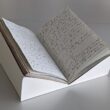Home University of Edinburgh Library Essentials
January 8, 2026
Repairs without the tears
Posted on January 7, 2014 | in Library & University Collections | by Sandi PhillipsIt’s a fact. Certain activities within a library are, by necessity, dull. While some may think that book repair falls into that category they would definitely be mistaken. At the busiest times of year the intrepid library assistant (myself) is greeted with shelves groaning with ‘poorly’ books – each with its own ailment.
Reserve and HUB books are dealt with first as a priority. Sections of a book that have come away cleanly from the spine can be dealt with rapidly – glue being the saviour here. Other pages that have come adrift may have tears in them. Lightweight, acid-free tape is the hero in these cases making the page and book serviceable once again. Sometimes an unscrupulous reader has torn out a section of the book. If the library holds multiple copies of that title then another copy is tracked down, relevant pages photocopied (adhering to copyright rules), pages trimmed and finally tipped (glued)-in. However, if the book is a sole copy, then I apply for an Interlibrary loan. Once the book loan has been received, the above process is carried out.
If a hardback book is falling apart and beyond my capabilities as an in-house repairer, then checks are made on Voyager to see if it is either heavily-used or a sole copy. If the book meets either of these criteria then it is sent to the external bindery to be re-bound. If a book is littered with pencil markings, then these have to be erased – quite a laborious process! Sometimes a new title has to be made to go on the spine for one which has faded and become illegible, or tape needs to be affixed to either the endpapers of the outer spine of a paperback. Occasionally pockets at the rear of a book have to be re-attached or a new pocket made for loose papers. Very occasionally a book comes to me which has suffered water damage. Usually a spillage of liquid making the pages go wavy. If the book has not been dried correctly, then pages will stick to each other rendering the book unreadable. In this scenario the only thing that can be done is to wave goodbye to the book. So, as you can see, there is a myriad of ailments which a book can suffer. It is very satisfying, though, knowing that you have made a book ‘better’ again, ready to boldly go once more into the book world of academia.
Now, what will be waiting for me today?
Collections
 Hill and Adamson Collection: an insight into Edinburgh’s past
My name is Phoebe Kirkland, I am an MSc East Asian Studies student, and for...
Hill and Adamson Collection: an insight into Edinburgh’s past
My name is Phoebe Kirkland, I am an MSc East Asian Studies student, and for...
 Cataloguing the private papers of Archibald Hunter Campbell: A Journey Through Correspondence
My name is Pauline Vincent, I am a student in my last year of a...
Cataloguing the private papers of Archibald Hunter Campbell: A Journey Through Correspondence
My name is Pauline Vincent, I am a student in my last year of a...
Projects
 Cataloguing the private papers of Archibald Hunter Campbell: A Journey Through Correspondence
My name is Pauline Vincent, I am a student in my last year of a...
Cataloguing the private papers of Archibald Hunter Campbell: A Journey Through Correspondence
My name is Pauline Vincent, I am a student in my last year of a...
 Archival Provenance Research Project: Lishan’s Experience
Presentation My name is Lishan Zou, I am a fourth year History and Politics student....
Archival Provenance Research Project: Lishan’s Experience
Presentation My name is Lishan Zou, I am a fourth year History and Politics student....

